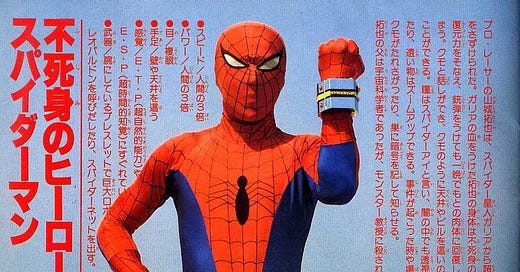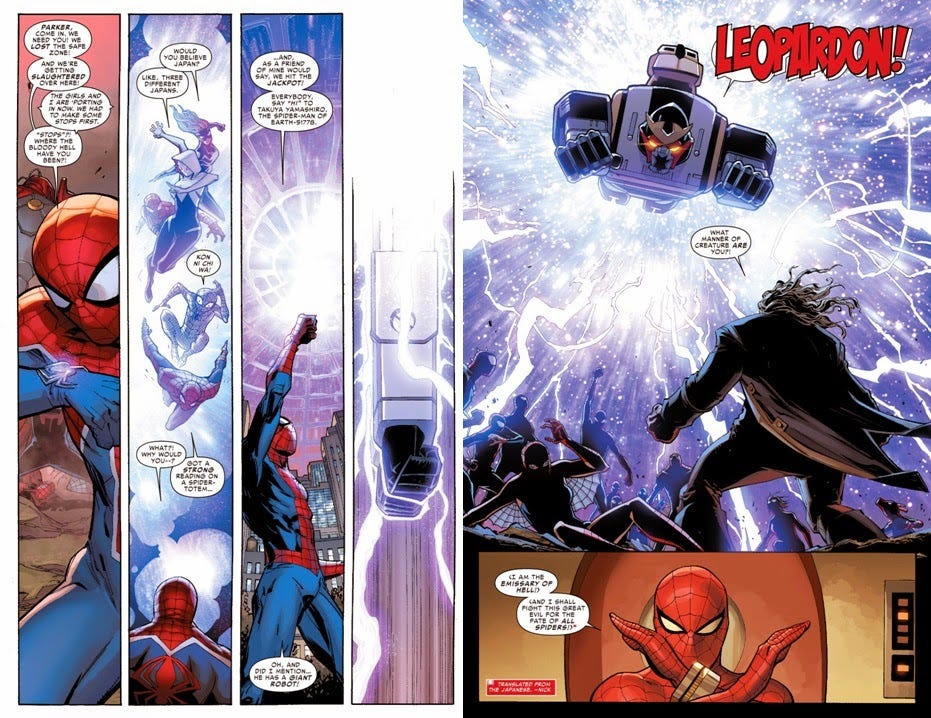This article is about exactly what you think it is. Spiderman in Japan. Now, you may be thinking this is about how Japan has embraced Spiderman and Western superheroes. In a way, it is. In a much realer way though, it is about a long-hidden bastardisation turned heroisation of Japanese television icon, スパイダーマン (“Supaidaman”).
Character characteristics
Adaptations of one country’s stories into another is common enough. Even with thousands of manga and anime characters, there is often a desire for Japan to look abroad. Yet the traits of foreign characters can feel particularly alien in Japanese media. Who could have guessed traditional American Spiderman’s origin story wouldn’t be exciting enough for Japan?
As many of us know, classic Spiderman is a teenager called Peter Parker. He is a massive nerd with a spider bite that grants him superpowers including super strength, web shooting, and spider sense. He remains a massive nerd. Petey boy decides to stop crime in New York City in a bright red and black jumpsuit after failing to save his Uncle Ben. Nerdhood is a big part of this Spiderman, and the bestowing of his powers was pure luck; Peter was in the right bite radius at the right bite time. Further, his commitment to justice comes as a result of trauma. Not being able to use his newfound powers to prevent a preventable tragedy is the driving force behind the defense of his hometown against criminals.
This Spiderman was a perfect hero for young American comic book readers in terms of aspirational attainment. It offered the allure that if you are lucky, that your very own spider bite may well result in a transformation into a superhero. More to the point, it was an egalitarian concept that anyone can become super.
Japan’s spidey senses were not tingling
These traits did not resonate with Japanese audiences in the 1970s. Like, at all. They liked the red jumpsuit and the name, and just about nothing else, so they took some artistic license in recreating him for local audiences. As a result, a Spiderman that looks exactly like the hire-a-superhero Hollywood Blvd character would be born.
There are the obvious changes that make sense, such as switching the race and changing the name of the lead to a more pronounceable and relatable Takuya Yamashiro. He is still a young man who conceals his secret identity, which grants him spider-like powers including super strength and sticking to walls. Here is where the similarities end.
Japan wasn’t looking for a bookish student as their superhero. There are enough of those. Takuya Yamashiro is the polar opposite, a motorcycle racer. You know. The accessible and normal profession for teenagers.
The origin story changed a little too. Instead of random chance, our young protagonist is chosen by a telepathic alien called Garia (stay with me). Garia has asked Yamashiro to find the crashed giant mecha-robot named Leopardon (remember this guy, he’ll come back later). But Garia is also captured in a cave by an evil vampiric overlord named Professor Monster. Yamashiro has a motorbike race, so he brushes Garia’s alien robot quest off and goes riding instead. Of course, then Yamashiro’s dad naturally tries to find Leopardon and gets killed by Professor Monster’s minion (okay, maybe the sacrificial family member trope knows no bounds). So finally Yamashiro tries finding Leopardon, just to fall into Garia’s prison cave. Sensing Yamashiro’s minimal fashion sense and current weak-character status, Garia gives him the Spider bracelet and Spider extract that gives our protagonist new powers. Yada yada yada, Yamashiro’s Spider Powers are too weak to defeat the minion, so he summons Leopardon, the giant mecha-robot. He then joins Interpol to take down Professor Monster. So the same classic tropes in every superhero origin story.
One or two of these elements may cause you to think that Japan’s Spiderman is a parody. With episodes that feature battles with 70s rock bands that attack him with the Spider-Boogie song, as well as “shark people”, a lot of clips of Supaidaman seem an outright fever dream.
Yet all these elements are played straight. The story arc and tone of the show is dark. He is an angry boy that is called to fight against the injustices of Professor Monster and is above the law. This means extrajudicial killings and morally questionable revenge narratives.
Tokusatsu together
Now, this might feel like a slight deviation from classic Spiderman. It is. That’s because Supaidaman is not a comic book character. It’s an entirely different genre. When Toei (makers of classic Japanese shows) bought the rights to make Spiderman, they had planned to make it in the Tokusatsu genre.
You might be wondering what Tokusatsu is. Reach inside your mind, and you’ll already know. It refers to the classic Japanese sci-fi SFX genre. Imagine any classic live-action Japanese scene that involves special effects. The sets with miniatures battling it out. Men who wear monster suits rampaging through a city.
From Godzilla to Ultraman, these genre pictures dominated the Japanese screens from the 1950s onwards. These were distinctly Japanese creations designed to provide the scale and gravitas of wild imaginations on a fraction of Hollywood’s budget. These became box office gold in Japan, with audiences always ready for more monsters.
Much like franchises of today, Japanese cinemagoers were tiring of sequels and remakes of other Tokusatsu intellectual property. Thus the production company Toei started to look elsewhere.
Almost at once, the red jumpsuit grabbed their eye. They lobbied Marvel Comics and their mini-king Stan Lee for the rights to make Spiderman Japan, but once the show had been filmed and finalised, the real battle began.
The Fight for the Rights
For whatever reason, Marvel thought that selling the rights to their character in Japan meant they’d treat the property with a high level of cultural nuance (as is often the case in 1970s foreign depictions). Yet in the cold reality of day, Japanese Spiderman was anything but the bookish nerd. Marvel decided that the world couldn’t be exposed to a cool Spiderman and immediately blocked all VHS releases of the show outside of Japan.
This meant that for most countries, the concept of a bracelet wearing, robot piloting, motorbiker Spiderman was a childhood rumour. People across the Western world were stuck with their vanilla white Peter Parker in New York City fighting the same rogue’s gallery of goblins and sand people, and denied the privilege of learning how Professor Monster was to be defeated.
Yet the safe bubble of comic isolation would be burst with the advent of the internet. Soon comicistas and fans around the world could exchange messages about their favourite superheroes, and it became harder for Marvel to hide Takuya Yamashiro.
By the turn of the millennium, Marvel was ready to acknowledge Supaidaman. The drip-drip-drip news started, with reports of Stan Lee “loving the Japanese adaptation that he never saw until 2005”, and the inclusion of Leopardon in Ready Player One. Supaidaman was free at last and released on DVD.
Nowadays Supaidaman has returned to Marvel’s good side. They’ve been incorporated into the extended universe or multiverse of the comic world, and were included in modern story arcs about the wider Spiderverse. There have even been rumours about his appearance in the cinematic depictions as a separate universe Spider hero.
The television show has become a cult classic and Leopardon a small-time media darling. Just like any good hero, the concept of Supaidaman lives on, long beyond the strict confines of its origins. From reviled to beloved, Supaidaman the intellectual property has followed the same narrative shifts that the character went through. Perhaps this is the proof that the American take on Spiderman was right: anyone can be a hero.







“…treat the property with a high level of cultural nuance (as is often the case in 1970s foreign depictions).” I love it!
A fascinating way into discussing cultural nuance. Thanks for sharing.